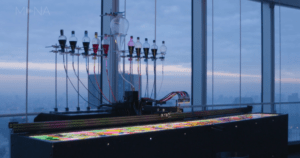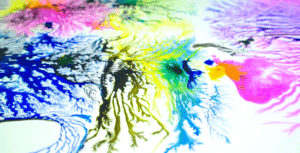“Two or more sides–whether human or other objects in a space and time–communicate, affect, react, and respond to each other in a certain way. It should mutually and alternately take in the information sent by the other side, processing the information, and making reactions based on the process.”
Above is the understanding, or personal definition of interaction in my group project research. I have to admit, even now my definition of “interaction” is still almost the same as the one in group research. However, what I find myself more interested in and more aware of is that, interaction can be something universal and extremely common on earth, even under primitive and natural status, like a chemical reaction, or the interaction between forces. A large part of those interactions can be completely boring or unattractive to most people.
But the goal of a successful interactive experience that we are pursuing is not merely an action that fulfills this definition, but also to have our users gain an unforgettable feeling, whether interested, excited, relaxed, inspired, or surprised. So for the first time, I seem to realize that the simple requirement of “interaction” is far from enough to attract people’s attention, but its ingenious combination with the creativity and imagination of people, and the interesting, artistic, or poetic form it is presented, that attaches more meanings to the whole process.
In other words, in my view, when it comes to a successful interactive experience, in which ways, or through which medium the interaction is conducted, is of equal value to the interaction movement itself.
For example, this project below made utilized the chemical reaction of water, ink, and chemical substances to create organic patterns with unexpected visual effects. In this project, the designers got inspiration from the basic chemical reaction, which seems boring alone without the artistic design, and uniquely combined multiple such reactions to create the art.
dyebirth _ ROPPONGI ART NIGHT 2017


Planner / Creative Director: Makoto Fukuchi
Hardware Engineer: Satoshi Nakane
Software Engineer: Shuhei Matsuyama
Sound Producer: Yui Onodera
Architect / Experience Designer: Kazuhiro Itagaki
Designer: Satoshi Kawamata
Scientist: Mafumi Hishida
Producer / Project Manager: Shigeyoshi Hayashi
2018-03-20
DigiScape-Forest
https://www.manamana.net/video/detail?id=1697190#!zh
by KeJyunWu 2021-09-20
The interaction in this project can be simplified to clicking, manipulating information, and giving feedback. The basic rule goes similarly as we click the keyboard to type in letters. But what makes this project amazing is the complicated computer processing design and how the feedback is presented on the screen. It seems that to create a good interactive experience, first, we have to master the “language”–in this class, that is interaction–and then use the language to create “literature”– the project or installation we make.
The complexity of the interaction process matters and the innovative way for the users to explore it matters as well. We can build some installations with the combination of designers’ creativity and unique ideas and interaction is the key point that accounts for a successful interactive experience. With this factor, the interaction can go beyond a simple thing that happens and ends, instead becomes possible to leave an impression on the user, and makes him want to explore more, do further steps, and triggers more interactions in the next stage.
